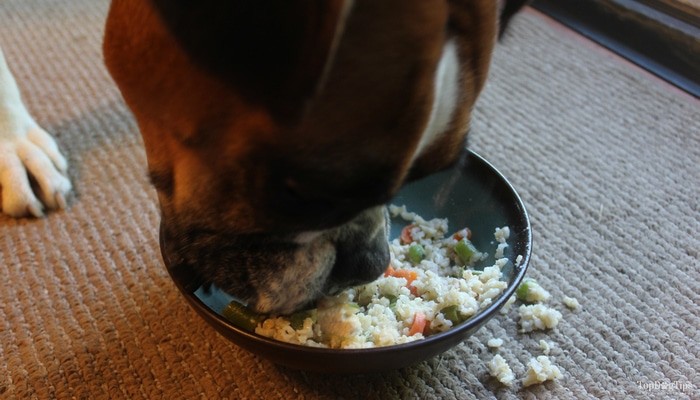Can Dogs Have Rice? Exploring the Benefits and Risks of Adding Rice to Your Dog’s Diet
As devoted pet owners, we always strive to provide the best care and nutrition for our furry companions. When it comes to our canine friends, questions about their diet often arise. One common inquiry is whether dogs can have rice. In this comprehensive guide, we’ll dive into the topic of feeding rice to dogs, shedding light on its benefits and potential risks.

Is Rice Safe for Dogs?
Understanding Rice in Dog Diets:
Rice, a staple in human diets across the world, has also found its way into many dog bowls. It’s important to recognize that rice can indeed be safe and even beneficial for dogs when introduced thoughtfully. Primarily used as a carbohydrate source, rice provides energy and serves as a gentle option for dogs with sensitive stomachs.
Types of Rice for Dogs:
Not all rice is created equal, and the same applies to our canine companions. When contemplating adding rice to your dog’s diet, understanding the different types is key. Brown rice and white rice are the two primary options. Brown rice retains its outer bran layer, making it a more nutritious choice due to higher fiber content. White rice, on the other hand, is more easily digestible and may be suitable for dogs with digestive issues.
Benefits of Feeding Rice to Dogs:
Digestive Ease and Sensitive Stomachs:
One of the notable benefits of incorporating rice into your dog’s diet is its gentle impact on digestion. Dogs with sensitive stomachs or those recovering from gastrointestinal issues may find solace in the bland and easily digestible nature of rice.
Energy Source for Active Dogs:
For our furry friends who lead active lifestyles, carbohydrates are essential for maintaining energy levels. Rice serves as a complex carbohydrate source, providing a steady release of energy to keep your pup fueled and ready for adventures.
Potential Aid in Upset Stomachs:
When your dog experiences tummy troubles, a simple diet can often help soothe discomfort. Rice, being a bland and low-fat option, can be beneficial during times of stomach upset or recovery from illness.
Important Considerations:
Rice Allergies and Intolerances:
While rice is generally well-tolerated by most dogs, it’s crucial to remain vigilant for any signs of allergies or intolerances. Watch for symptoms like vomiting, diarrhea, or skin reactions after introducing rice to your dog’s diet.
Portion Control and Nutritional Balance:
As with any addition to your dog’s diet, moderation is key. Incorporating rice should be part of a well-balanced diet that includes other essential nutrients. Consult your veterinarian for guidance on appropriate portion sizes based on your dog’s size, age, and activity level.
Preparing Rice for Dogs:
When preparing rice for your canine companion, it’s essential to keep things simple. Opt for plain, cooked rice without any additives, spices, or seasonings. Avoid using butter, oils, or salt, as these can be harmful to dogs.
Incorporating Rice into Dog Diets:
Consulting a Veterinarian:
Before making any significant changes to your dog’s diet, including the addition of rice, it’s vital to consult with a veterinarian. A professional evaluation ensures that your dog’s specific nutritional needs and potential sensitivities are taken into account.
Gradual Introduction and Monitoring:
When introducing rice to your dog’s diet, it’s wise to do so gradually. Start by offering a small portion mixed with their regular food. Observe their reaction and any changes in their stool or behavior. Gradual introduction helps your dog’s digestive system adapt.
Alternatives to Rice:
While rice can be a valuable addition, it’s not the only option. Other easily digestible carbohydrates include oatmeal and quinoa. Sweet potatoes and pumpkin are also popular choices, offering added vitamins and fiber.
Can Dogs Have Rice? Frequently Asked Questions
Q1: Is rice safe for dogs?
A1: Yes, rice can be safe for dogs when introduced in moderation. It can serve as a source of energy and be gentle on their digestive system.
Q2: Can I give my dog rice every day?
A2: While rice can be included in your dog’s diet, it’s important to provide a balanced and varied diet that meets their nutritional needs.
Q3: What type of rice is best for dogs?
A3: Both brown and white rice can be suitable for dogs. Brown rice offers more fiber, while white rice is more easily digestible.
Q4: How should I prepare rice for my dog?
A4: Prepare plain, cooked rice without any seasonings, spices, or additives. Avoid using butter, oils, or salt.
Q5: Can rice help with my dog’s upset stomach?
A5: Yes, plain rice can be beneficial for dogs with upset stomachs as it’s bland and easy to digest. However, consult your vet if symptoms persist.
Q6: Can rice cause allergies in dogs?
A6: While rice is rarely an allergen for dogs, allergies can vary. Monitor your dog for any adverse reactions after introducing rice.
Q7: How much rice can I feed my dog?
A7: Portion sizes depend on your dog’s size, age, and activity level. Consult your veterinarian for personalized recommendations.
Q8: Can rice be part of a homemade dog food diet?
A8: Yes, rice can be included in homemade dog food recipes. Ensure the diet is balanced and meets your dog’s nutritional needs.
Q9: Are there alternatives to rice for dogs?
A9: Yes, other options include oatmeal, quinoa, sweet potatoes, and pumpkin. Consult your vet to choose what’s best for your dog.
Q10: Should I consult a vet before giving my dog rice?
A10: Yes, it’s advisable to consult your veterinarian before introducing new foods like rice into your dog’s diet to ensure their well-being.
Conclusion
In the quest to provide optimal care for our canine companions, understanding what they can and cannot consume is essential. Can dogs have rice? The answer is yes, but with careful consideration. Rice can be a safe and nutritious addition to your dog’s diet when introduced mindfully and in moderation.




